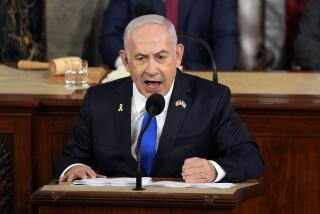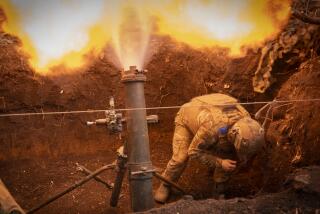U.S. Arms Sales Soar in 3rd World : Weapons: Value more than doubles in 1990 to $18.5 billion, making America the No. 1 supplier.
WASHINGTON — U.S. weapons sales to the Third World more than doubled last year, making America the world’s top arms supplier, an annual congressional report has found.
The growth in U.S. arms sales--to $18.5 billion in 1990 from nearly $8 billion in 1989--is attributed to the Iraqi threat in the Persian Gulf and to shrinking Pentagon budgets. These smaller budgets are forcing defense contractors to sell abroad or go under, said the report by the Congressional Research Service.
For the first time since 1983, the United States ranked at the top of the list of arms suppliers to Third World nations. It accounted for 44.8% of all weapons agreements, up from 23.6% the previous year, said the report, written by Richard F. Grimmett, a defense expert.
This data comes as the Administration is discussing an initiative announced earlier this year by President Bush to curb weapons sales to the Middle East by the five top suppliers--the United States, the Soviet Union, China, Britain and France.
The plan, discussed at a Paris conference last month of all five nations, was prompted by the massive Iraqi military buildup of the 1980s that culminated in its Aug. 2 invasion of Kuwait.
The Iraqi invasion, however, led to accelerated arms purchases by Kuwait’s neighbor, Saudi Arabia, which also felt threatened.
The value of 1990 U.S. weapons agreements with Saudi Arabia--$14.5 billion--exceeded the total worth of all Soviet arms deals with the Third World in the same year--$12.1 billion, according to Grimmett’s data, collected from the Defense Department and other sources.
Not all the sales with the Saudis were concluded after the invasion. About $6.1 billion in deals were signed before Aug. 2, the report said.
The Administration is planning to ask Congress for another massive weapons sale to Saudi Arabia of $14.5 billion worth of fighter planes, tanks and other arms.
If approved, the sales would be a boon for U.S. defense contractors suffering from the shrinking defense budgets of the last two years.
“Because of reductions in defense procurement in the United States resulting from the Cold War’s end, American arms producers began to focus greater attention on obtaining foreign markets for their weapons to compensate partially for shrinking domestic orders,” Grimmett wrote.
Similar reductions in the budgets of West European suppliers are creating intense competition for Third World markets, especially in countries that can afford to pay cash for the weapons--the oil-rich Persian Gulf states.
The arms deals resulting from the Iraqi invasion reversed a three-year overall decline in the value of arms transfers to the Third World. The trend toward lower sales had begun in 1987 as the Iran-Iraq War was winding down.
China ranked fourth among the major suppliers in the period from 1987-1990, becoming Iran’s largest arms seller with $3 billion worth of deals signed in those years.
The four major West European suppliers--France, Britain, Germany and Italy--all experienced sharp drops in their Third World sales. They fell from a 22.4% share of Third World sales in 1989 to 10.3% last year, Grimmett found.
Saudi Arabia and Iraq were by far the largest recipients of Third World arms between 1983-90, buying $57.3 billion and $30.4 billion respectively, according to the data.
The total value of all Third World arms agreements from 1983 to 1990, the report said, was $301.7 billion, of which the Saudis bought 19% and the Iraqis 10.1%.
More to Read
Sign up for Essential California
The most important California stories and recommendations in your inbox every morning.
You may occasionally receive promotional content from the Los Angeles Times.










